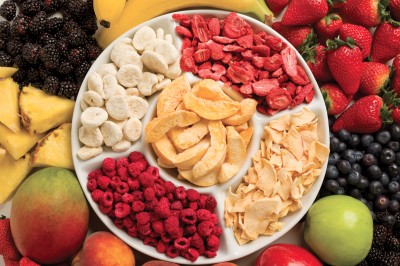
Images source: thrivewithjodie.com
Building a long-term food storage supply can be both a daunting and expensive task – but it does not have to be. As many off-the-grid, homesteading, and prepper families already know, canning produce and meat grown and raised on the farm is a wonderfully inexpensive way to stock up on food with a long shelf life. Dehydrated and freeze dried food also have benefits, including a potentially far longer shelf life than home canned food.
Some folks prefer freeze dried over dehydrated food, but both varieties have advantages and disadvantages. Read labels of any purchased long-term storage food carefully if organic status, gluten, GMOs, or vegetarian dietary needs are a concern.
Pros and Cons of Freeze Dried Food
Freeze dried food is flash frozen and then placed inside a vacuum pouch or container. Unlike the long dehydrating process, water in freeze dried food vanishes quickly. The fast removal of moisture prevents the food from shriveling or looking “deformed” as it can often do during the dehydration process. Typically, freeze dried food rehydrates more quickly than dehydrated food. Water and time (i.e. patience) are needed for both types of long-term storage food. If time is of the essence or fuel is in short supply during an emergency situation, the minutes and energy saved by using freeze dried food could be a significant factor to consider when deciding how to spend your long-term food storage dollars.
Pros and Cons of Dehydrated Food
Purchasing a moderately priced home dehydrator would allow you to make your own long-term food storage items, but remember to factor the cost of electricity into the decision. My dehydrator cost about $65 when I got it on sale. It works wonderfully and has allowed me to make dehydrated eggs, cottage cheese, sour cream, jerky and countless fruits and vegetables. Slicing or spreading the food items to be dehydrated is key to reducing the amount of energy used during the process. Solar dehydrators for outdoor use are both commercially available and can be made fairly simply at home as well.
Are You Ready For The Coming Food Riots?
Dehydrating your own produce, meat and poultry offers not only a cost savings but the peace of mind of knowing exactly what you will be serving your family. A multitude of free recipes exist online that include dehydrated food items, and long shelf life baking products that can be placed inside a Mason jar for quick and easy snacks and meals several years into the future. Commercially dehydrated food has a plethora of varieties.
Shelf Life
Both dehydrated and freeze dried foods have a long and similar shelf life. They are both stable products when stored in a cool, dry place – just like with home canned items. Freeze dried foods inside a Mylar pouch should keep the product fresh for a decade. Dehydrated foods have been estimated to last for 20 years or more. Freeze dried foods in a #10 can are estimated to last up to 25 years – that is, until opened. Once a #10 can of freeze dried food has been opened, all the contents inside must be used within several days – not so with dehydrated food, as long as the unused portion does not get wet.
Home Dehydrating Tips
- Cleanliness is the key to a quality dehydrated food item which will both have a long-term shelf life and not make you sick when you finally eat it. Wash all fruits, vegetables and meats thoroughly before placing them on dehydrator trays.
- Scour the dehydrator trays, plastic liner inserts (used for liquids and small pieces of food) bottom tray, and the bottom of the cover after each use. Even if your trays show no sign of food particles, the plastic pieces can hold bacteria that will ruin your food.
- All items should be crispy before they are taken out of the dehydrator – even dairy. I dehydrated cottage cheese and sour cream for 10 hours at 135 degrees. The sour cream resembled a sheet of ice and the cottage cheese looked like peanut brittle. Dehydrating eggs is extremely easy. Crack a dozen eggs and pour the mix into a blender to thoroughly mix. Pour half of the mixture onto each tray. Dehydrate for 12 hours on 135-140 degrees. Powder the eggs by putting them into food processor or blender to maximize storage space. Mix one tablespoons of egg with two tablespoons of water and wait five minutes for them to rehydrate. Use them eggs to scramble or bake with as you would fresh eggs.
Sign up for Off The Grid News’ weekly email and stay informed about the issues important to you
 Off The Grid News Better Ideas For Off The Grid Living
Off The Grid News Better Ideas For Off The Grid Living




